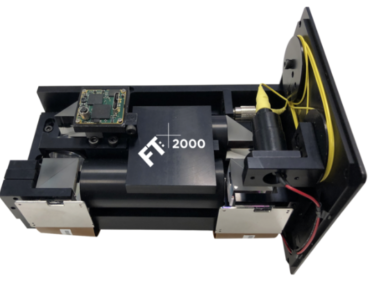Optalysys Switches on Commercial Optical Co-Processor

Source: Optalysys
Optalysys, Ltd., a U.K. company seeking to advance it optical co-processor technology, moved a step closer this week with the unveiling of what it claims is the first commercial optical processor aimed at emerging AI applications.
Yorkshire-based Optalysys on Thursday (March 7) announced commercial availability of its FT:X 2000 optical processor, which the company promotes as a post-Moore’s Law alternative. The low-power processor is aimed at computing-intensive AI workloads such as high-resolution image and video applications.
Optalysys said the FT:X 2000 can be programmed either through an API or a TensorFlow interface to perform optical correlation functions and convolutional neural network (CNN) implementations used for AI-based pattern recognition. The “entry-level system” operates at up to 2,400 frames per second with resolution measuring 2,048 by 1,536.
“We are seeing a surge in interest in optical methods, which are needed to provide the next level of processing capability across multiple industry sectors,” said Optalysys CEO and founder Nick New.
Optalysys and other optical AI processor startups are seeking to replace electrons with photons as a processing alternative for performing high-resolution calculations. The co-processors enable pattern-based data like gene sequences to be crunched at speeds much faster than silicon chips. Among the implementations is pre-processing data to boost the performance of models based on convolutional neural networks used for high-resolution data applications.
The company’s technology passes light through layers of tiny LCDs using a low power laser. Data is then encoded by applying varying voltages to the LCDs. That step modifies their optical density and modulates the resulting waveform.
The net result is analog encoding of numerical data onto the light. The emerging waveforms diffract from the LCD lattice and interact in ways that essentially perform Fourier transforms. Various functions can then be performed depending on the LCD arrangement.
Optalysys touts its design as a scalable approach that can perform full-resolution processing of multi-mega-pixel image and video data, or pre-process data for boosting the performance of CNN-type models used in high-resolution data applications.
This time last year, the company announced completion of a genetic search project with Earlham Institute designed to accelerate gene sequencing while greatly reducing processing power consumption.
Related
George Leopold has written about science and technology for more than 30 years, focusing on electronics and aerospace technology. He previously served as executive editor of Electronic Engineering Times. Leopold is the author of "Calculated Risk: The Supersonic Life and Times of Gus Grissom" (Purdue University Press, 2016).











